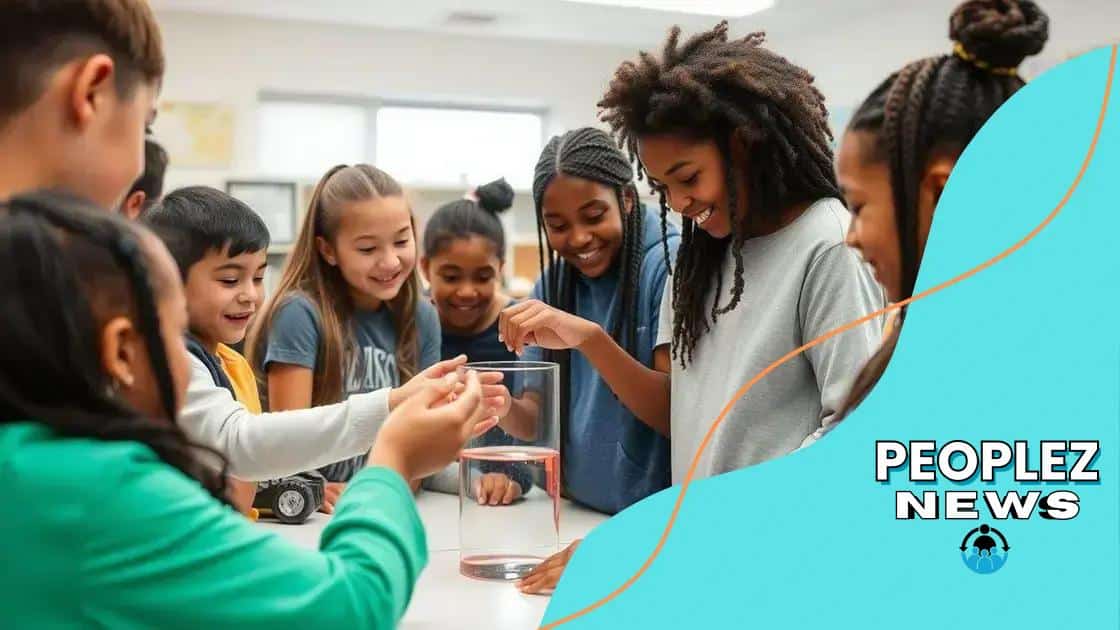STEM education programs for underrepresented groups

STEM education programs for underrepresented groups enhance diversity and innovation by addressing barriers and providing resources, mentorship, and hands-on experiences that empower all students to pursue careers in science, technology, engineering, and mathematics.
STEM education programs for underrepresented groups are pivotal in fostering diversity in science and technology fields. Have you ever wondered how these initiatives can change the narrative for many aspiring students? Let’s dive in.
Understanding STEM education programs
Understanding STEM education programs is crucial for promoting inclusivity in the science, technology, engineering, and mathematics fields. These programs aim to engage students from diverse backgrounds by offering tailored learning experiences.
Key Features of Successful Programs
Effective STEM education programs incorporate several key features that make them successful:
- Hands-on learning opportunities that spark interest.
- Mentorship from professionals in the field.
- Support systems for students facing challenges.
- Community involvement to deepen engagement.
Another important factor is fostering a supportive environment where students feel safe to explore. Many programs focus on building confidence, which is essential for retention in STEM disciplines. When students are encouraged to ask questions and experiment, they develop a deeper understanding of complex concepts.
Addressing Challenges in STEM Education
Many underrepresented groups face unique challenges when entering STEM education programs. These challenges can include:
- Lack of access to resources.
- Socioeconomic barriers that hinder participation.
- Limited exposure to STEM fields at an early age.
By recognizing these challenges, programs can implement strategies to overcome them. For instance, offering scholarships or funding for materials can mitigate financial barriers. Additionally, outreach programs that introduce students to STEM at a young age can help create a pipeline of future professionals.
Moreover, partnerships with local businesses and organizations can enrich these educational experiences. By working together, they can offer internships, real-world projects, and networking opportunities that enhance learning beyond the classroom.
The Impact of Engaging Curricula
Engaging curricula often include real-world applications of STEM concepts, making learning more applicable and exciting. When students see how STEM relates to everyday life, their interest can grow significantly. Creative projects, competitions, and interactive learning environments also play a pivotal role in drawing students into the world of STEM education.
Barriers faced by underrepresented groups
Barriers faced by underrepresented groups in STEM education programs are significant and can hinder participation and success. Understanding these barriers helps educators develop effective strategies to support diverse learners.
Common Challenges
Many students from underrepresented backgrounds struggle with different obstacles that can discourage their engagement in STEM fields. These challenges might include:
- Lack of access to advanced coursework in science and mathematics.
- Limited exposure to role models in STEM.
- Financial constraints that make participation difficult.
- Cultural stereotypes that negatively impact confidence.
These barriers can create a cycle of disadvantage, making it harder for students to envision themselves in STEM careers. For example, without access to advanced classes, some students may not develop the foundational skills necessary for success in higher education.
Socioeconomic Factors
The socioeconomic status of students can also play a crucial role in their access to STEM education programs. Students from low-income families may encounter challenges such as:
- Inadequate access to technology and resources.
- Stress from financial instability that distracts from learning.
- Transportation issues that limit attendance in essential programs.
Additionally, schools in lower-income areas often lack the funding necessary to provide quality STEM education, further widening the gap. When students do not receive encouragement or resources, their interest in these fields can diminish.
Furthermore, family expectations and community support can significantly impact a student’s decisions about pursuing STEM education. If students don’t see a path forward, they might not seek opportunities available to them, leading to persistent underrepresentation.
Overcoming the Barriers
To tackle these challenges, many organizations are working to create supportive environments for underrepresented groups. Initiatives such as mentorship programs, scholarships, and community outreach are essential in breaking down these barriers. By providing guidance and support, students can navigate obstacles that might otherwise deter their interest and participation in STEM.
The importance of diversity in STEM

The importance of diversity in STEM cannot be overstated. Having a wide range of perspectives enhances creativity and innovation, which are crucial for scientific and technological advancements. When individuals from various backgrounds collaborate, they contribute unique insights that lead to more effective problem-solving.
Benefits of Diverse Teams
Research shows that diverse teams outperform homogenous ones. Here are some benefits of having diversity in STEM:
- Increased creativity and innovation through varied viewpoints.
- Enhanced decision-making with different perspectives.
- Improved performance and productivity in project work.
- Broader market reach due to diverse experiences.
When teams reflect the demographics of the population, they can create products and services that better meet the needs of all users. Furthermore, companies with diverse workforces often report higher employee satisfaction, which leads to lower turnover rates and retains talent.
Addressing Underrepresentation
Despite the benefits, many STEM fields still lack representation from diverse groups. This underrepresentation can stem from various barriers such as education, access to resources, and cultural perceptions. Programs that focus on inclusivity help to bridge these gaps.
By promoting access to STEM education for traditionally underrepresented groups, organizations can build a talent pipeline that enriches the field. This can be achieved through outreach efforts, mentorship programs, and scholarships designed to support students from diverse backgrounds.
Creating an inclusive environment where everyone feels valued is essential for attracting and retaining talent. Recognizing the importance of diversity in STEM promotes a culture of respect and equity, making STEM fields more accessible to all.
Successful case studies
Successful case studies in STEM education programs offer valuable insights into how effective strategies can increase participation among underrepresented groups. These real-world examples show what works, inspiring new initiatives and demonstrating the positive impact of inclusivity.
Case Study 1: The STEM Academy
The STEM Academy is a notable example of a program designed to reach underrepresented students. By focusing on hands-on learning, the academy engages students with real-world projects. The curriculum emphasizes collaboration and includes mentorship from professionals in the field.
Key features that contributed to its success include:
- Individualized support for students
- Partnerships with local businesses
- Workshops and events that build community
As a result, the program significantly increased the number of students pursuing STEM degrees, particularly among girls and students of color.
Case Study 2: Tech for All
Tech for All is another successful initiative that provides coding and technology skills to underserved communities. This program attracts diverse participants by offering free courses and resources. Additionally, it fosters a welcoming atmosphere that encourages all students to explore technology.
Highlights of the program include:
- Accessible online courses for flexible learning
- Networking opportunities with tech companies
- Scholarships for advanced training
Through these efforts, Tech for All has helped countless students secure jobs in the tech industry, creating a pathway to successful careers.
Case Study 3: Girls Who Code
Girls Who Code focuses specifically on closing the gender gap in technology. The organization provides after-school clubs, summer programs, and camps for girls. By creating a supportive environment, it encourages young women to pursue coding and computer science.
Some approaches that have made Girls Who Code successful include:
- Empowering female role models as instructors
- Fostering a strong community of peers
- Hands-on projects that build confidence and skills
This program has empowered thousands of girls, sparking interest in STEM careers and helping to cultivate a more inclusive workforce.
Future trends in STEM education
Future trends in STEM education are shaping how we prepare the next generation for careers in science, technology, engineering, and mathematics. As the world evolves, so do the educational strategies that aim to create a more inclusive environment.
Emphasis on Technology Integration
Technology is becoming increasingly important in STEM education. Schools are integrating advanced tools such as virtual reality and artificial intelligence to enhance learning experiences. This integration allows students to engage in simulations and interactive projects, making learning more exciting and relevant.
Some components driving this trend include:
- Incorporation of coding into the curriculum.
- Use of robotics and automated systems in projects.
- Online learning platforms that offer flexibility.
This technology-based approach not only increases engagement but also prepares students for a future where digital skills are essential.
Focus on Collaborative Learning
Another key trend is the focus on collaborative learning. Teamwork is vital in STEM fields, and educational programs are increasingly designed to foster this skill. Collaborative projects encourage students to work together, share ideas, and solve problems, building essential communication skills.
Benefits of collaborative learning include:
- Enhanced creativity and problem-solving abilities.
- Development of social skills and confidence.
- Exposure to diverse perspectives and experiences.
As students collaborate, they learn how to support each other’s strengths and address weaknesses, truly preparing them for the workforce.
Diversity in Curriculum
Future trends also emphasize the importance of diversity in curriculum design. Inclusive materials and teaching practices are becoming standard in STEM education. This approach not only enriches content but also promotes representation of varied cultures and perspectives.
By diversifying curricula, educators can:
- Attract a broader range of students.
- Inspire traditionally underrepresented groups.
- Encourage critical thinking about global challenges.
This focus on diversity can lead to more innovative solutions as students learn to appreciate different viewpoints and experiences.
Career Readiness Programs
Finally, career readiness programs are gaining ground within STEM education. Many schools are partnering with local businesses to provide internships, mentorships, and real-world project experiences. These opportunities help students gain practical skills and insights into potential career paths, making education more relevant.
Such initiatives are crucial as they:
- Connect classroom learning to real-world applications.
- Foster professional networks and relationships.
- Enhance student engagement with tangible outcomes.
By focusing on career readiness, educational institutions are equipping students with the tools necessary for success in competitive job markets.
In conclusion, expanding STEM education programs for underrepresented groups is vital for building a more inclusive future. By understanding the barriers that exist and focusing on diversity, collaboration, and technology integration, we create opportunities for all students. Successful case studies show that when we invest in equitable education, we can ignite curiosity and innovation, leading to brighter prospects for future generations. With career readiness initiatives, students gain the skills they need to thrive in today’s job market. Together, we can pave the way for a diverse talent pool in STEM fields that reflects our society as a whole.
FAQ – Frequently Asked Questions about STEM Education Programs
What are STEM education programs?
STEM education programs focus on teaching science, technology, engineering, and mathematics, encouraging critical thinking and problem-solving skills.
Why is diversity important in STEM education?
Diversity in STEM education fosters creativity and innovation by bringing together different perspectives, which leads to better solutions and a more inclusive field.
What challenges do underrepresented groups face in STEM?
Underrepresented groups often encounter barriers such as limited access to resources, socioeconomic challenges, and a lack of role models in STEM fields.
How can schools improve STEM participation among diverse students?
Schools can enhance participation by implementing mentorship programs, promoting inclusive curricula, and fostering partnerships with local businesses to provide real-world experiences.





